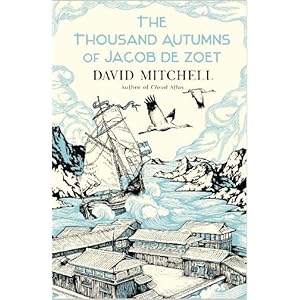David Mitchell's fifth novel is his third to feature Japan as a setting, but does mark a new departure by being a historical novel. It is the story of Jacob de Zoet, a clerk working for the Dutch East India Company in the enclave on the island of Dejima near Nagasaki, in 1799 the only place where Europeans were permitted to trade with the Japanese (see the informative Wikipedia article on this here). The story starts when Jacob arrives in Japan, accompanying a new governor for the enclave, whose mission is to fight the endemic corruption among the Company traders, more interested in self-enrichment than the success of the Company as a whole. Jacob soon falls in love with an absolutely unattainable woman, a young girl of good breeding who is one of the students of a Western doctor on Dejima. (Her backstory is quite complicated, to explain how a woman who is neither a prostitute nor a concubine could meet a European, given that such women would normally neither be allowed on the island nor permitted to study Western medicine.)
The Thousand Autumns is a novel about culture clash, between two representatives of two countries effectively in decline. During the novel, the Netherlands is conquered by the French Revolutionary armies, after which its status as a colonial power is greatly lessened; the Japanese shoguns continue the policy of seclusion until 1853 (when the American navy forces the borders to be opened more fully) but even in 1799 it is pretty clear that this end is inevitable in the face of superior technology.
Like Ghostwritten, The Thousand Autumns has a supernatural element, in the doings of villainous abbot Enomoto. Through a bloody ritual involving the sacrifice of babies born to coerced and drugged nuns, he has gaind himself an unnaturally extended lifespan. It is tempting to believe that he is some kind of magic realist symbol, like the children in Midnight's Children, in this case an embodiment of the tyrannical and outdated isolationist regime of the Shogun. The picture of Japan on the cusp of the nineteenth century painted in this novel is pretty repellent, made up of fear, paranoia, and cruelty. Most of the European characters are not much better, either, being depicted as bigoted, uncultured, crude, and venal. Enomoto is not like most of the other Japanese characters, while the Europeans are less nasty but their vices are more widespread through the population.
With a historical novel, the question which is always asked is how accurate it is (though the answer does not necessarily make much difference to how enjoyable or interesting it is to read). Mitchell apparently went to a great deal of trouble to ensure that the details were accurate, but his own emotional reaction to the society may colour his writing about it; but even so, I would certainly not wish to have lived there and then. The attention to detail definitely makes the novel very convincing. This is not an episode of history I was particularly knowledgeable about, and it does make for a fascinating novel.
Not as good as Ghostwritten or numberNineDream, but more straightforward (and to my mind infinitely superior as a historical novel to Hilary Mantel's overrated Wolf Hall), I rate The Thousand Autumns of Jacob de Zoet at 8/10.
Edition: Sceptre, 2010
Review number: 1429
Saturday, 13 August 2011
David Mitchell: The Thousand Autumns of Jacob de Zoet (2010)
Subscribe to:
Post Comments (Atom)




No comments:
Post a Comment